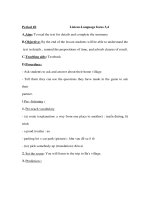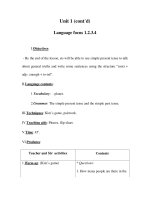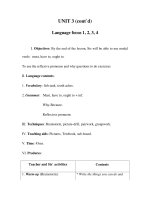3 4 living in different environments (life sciences)
Bạn đang xem bản rút gọn của tài liệu. Xem và tải ngay bản đầy đủ của tài liệu tại đây (7.23 MB, 14 trang )
Life Sciences
Standards
Preview
Standard Set 3. Life Sciences
3. Adaptations in physical structure or
behavior may improve an organism’s
chance for survival. As a basis for
understanding this concept:
3.b. Students know examples of
diverse life forms in different
environments, such as oceans, deserts,
tundra, forests, grasslands, and
wetlands.
3.a. Students know plants and animals
have structures that serve different
functions in growth, survival, and
reproduction.
Genre
Nonfiction
Comprehension Skill
Text Features
Main Idea and Details • Captions
• Text Boxes
• Glossary
Science Content
Adaptations
Scott Foresman Science 3.4
ISBN 0-328-23526-1
ì<(sk$m)=cdfcgb< +^-Ä-U-Ä-U
Vocabulary
adaptation
biome
desert
grassland
tundra
wetland
by Trish West
Picture Credits
Illustrations
8 Robert Ulrich.
Photographs
Every effort has been made to secure permission and provide appropriate credit for photographic material. The
publisher deeply regrets any omission and pledges to correct errors called to its attention in subsequent editions.
Unless otherwise acknowledged, all photographs are the copyright of Dorling Kindersley, a division of Pearson.
Photo locators denoted as follows: Top (T), Center (C), Bottom (B), Left (L), Right (R), Background (Bkgd).
4 (TL) ©Kevin Schafer/Corbis, (CR) ©Gary W. Carter/Corbis; 5 (B) ©Vittoriano Rastelli/Corbis; 6 (B) ©Ken Lucas/Visuals
Unlimited; 7 (T) ©W. Perry Conway/Corbis, (CL) ©John Cancalosi/Nature Picture Library; 8 (TL) ©Dennis Flaherty/
Getty Images, (CL) Bobbe Z. Christopherson, (BL) ©Gregory Ochocki/Photo Researchers, Inc.; 9 (TR) ©Andrew Brown;
Ecoscene/Corbis, (BR) ©Enzo & Paolo Ragazzini/Corbis, (CR) ©Andy Binns/Ecoscene, (B) ©Ken Lucas/Visuals Unlimited;
10 (TL) ©Christine M. Douglas/DK Images, (B) ©Enzo & Paolo Ragazzini/Corbis; 11 (TR) ©Steve Kaufman/Corbis;
12 (B) ©Lou Jacobs Jr./Grant Heilman Photography; 13 (B) ©J. Eastcott/Y. Eastcott Film/NGS Image Collection, (TR)
©Richard R. Hansen/Photo Researchers, Inc.; 14 (TR) Daniel J. Cox/Natural Exposures, (Bkgd) ©Andy Binns/Ecoscene;
15 (TL) Daniel J. Cox/Natural Exposures; 16 (B) ©Jim Brandenburg/Minden Pictures; 17 (T) ©Jay Dickman/Corbis, (BL)
©Catherine Gehm/Stock Connection; 18 (B) ©Jim Brandenburg/Minden Pictures; 19 (TR) ©Gerry Ellis/Minden Pictures;
21 (TL) ©Rich Reid/NGS Image Collection; 22 (L) ©Frank Greenaway/DK Images; 23 (TR) ©Natural Visions/Alamy Images.
ISBN: 0-328-23526-1
Copyright © Pearson Education, Inc. All Rights Reserved. Printed in the United States of America.
This publication is protected by Copyright, and permission should be obtained from the publisher prior to any
prohibited reproduction, storage in a retrieval system, or transmission in any form by any means, electronic,
mechanical, photocopying, recording, or likewise. For information regarding permission(s), write to
Permissions Department, Scott Foresman, 1900 East Lake Avenue, Glenview, Illinois 60025.
1 2 3 4 5 6 7 8 9 10 V010 13 12 11 10 09 08 07 06
What structures
help plants and
animals live and
grow?
Living things need food, air, water, and space.
They need to stay protected and make offspring.
Plants make their own food. They use the Sun’s
energy and the air’s carbon dioxide to make it.
Adaptations
Plants and animals live in many different kinds
of places. Living things have features and abilities
that help them live. Each body part or ability that
helps a plant or animal to live in a place is an
adaptation.
Adaptations for Getting Food
Animals have adaptations to help them get
food. Some birds have webbed feet so they can
swim to get food. Other birds can use their feet to
hold food tightly.
They also need water and nutrients from the soil.
Animals cannot make their own food. They
must eat plants or other animals. Animals need
This is a hyena skull. Hyenas
have adaptations for eating meat.
oxygen and water. They also need shelter.
2
3
Adaptations for Protection
The flamingo’s long,
curved bill helps it get
food in shallow water.
How an animal looks and acts can help it stay
alive. Some animals’ bodies are a color or pattern
that is hard to see. This is called camouflage. Other
animals look like a more dangerous animal. Some
animals use chemicals to protect themselves.
Others may run, swim, or fly away from danger.
Some animals have body parts such as sharp
teeth or hard shells. They use these parts to protect
themselves from enemies.
The cardinal’s short,
strong bill helps it
break open seeds.
The porcupine’s sharp quills
help protect it from enemies.
Bird Bill Adaptations
Birds have bills to help them catch and eat food.
They have different bills depending on what they
eat. Cardinals, warblers, and pelicans can live in
the same place. But they all have different bills.
This means they all eat different kinds of food.
4
5
What are different
environments
where things live?
Bobcats hunt mostly
in daylight.
Biomes
A biome has a similar year-round weather
pattern and supports similar living things. Plants
and animals in a biome are adapted to live there.
Cottontails eat leaves
and soft bark. Coyotes
and bobcats hunt them.
A California Biome
Chaparral is a biome found on California hills. It
has mild, wet winters and hot, dry summers. Small
evergreen shrubs grow there. They have thick,
waxy leaves that hold in water. Their roots and
seeds can survive fires. Then new shrubs can grow.
Animals That Live in the Chaparral
Desert cottontails hide under shrubs in the
chaparral. Coyotes and bobcats hunt them.
Cottontails try to escape by running in zigzags.
Coyotes eat more kinds of food than bobcats
do. The two animals do not always eat at the same
times. These adaptations mean there is enough
food for them both.
6
7
Biomes of North America
North America has many biomes. Each one
takes up a large area. Plants are the main source of
food energy in a biome. This is why many biomes
are named for important plants that grow there.
Rain Forest
Tundra
Sitka spruce and
western hemlock
trees are adapted
to the cool, wet
weather there.
Strong, cold, dry
winds blow here.
Plants stay alive by
growing close to the
ground.
Wetland
Salty tides and mud
provide food for the
living things there.
Many wetlands have
just fresh water.
Grassland
There is enough rain
here for grasses and
flowering plants.
Few trees grow in a
grassland.
Ocean
Chaparral
Forests of giant kelp
grow in the water
off the west coast.
They support a lot of
living things.
8
Desert
Many plants here
have roots that
spread out a lot.
This helps them get
water in a dry place.
Shrubs grow close
together. Fires
break out and
spread during hot,
dry summers.
9
How do living things
survive in places
with few trees?
A grassland is a kind of biome. Grasslands
Indian grass and little bluestem grow well in a
grassland. Their roots grow deep into the ground.
This adaptation is helpful in many ways. The roots
survive even when grazing animals eat the plants.
The roots also survive when fire or cold kill the
plants above ground. The roots store food in winter.
They help the plants get water in the dry summers.
have many grasses and flowering plants, but few
trees. Grassland summers can be hot and dry,
while the winters are often cold. Trees grow poorly
there because there is not enough water for them.
This blazing
star grows in
a grassland.
10
Bison once lived in
grasslands. Their
teeth are adapted
for eating plants.
11
Desert
A desert is another kind of biome. Deserts get
very little rain. Days in a desert are often hot, but
nights can get cold. Deserts are not just sand. They
can be full of life.
Many desert animals hide during the hot day.
They come out at night. The dark night protects
them from animals that hunt them.
Many desert animals rarely drink water.
Instead, their bodies get water from their food.
A cactus is a desert plant. It has adaptations
for living in a desert. A cactus makes food with its
stems. Cactus stems expand to store rain water.
The kangaroo rat gets
water by eating seeds. It
stores food in its cheeks.
The stems’ thick covering stops water loss. Cactus
leaves are sharp spines. These leaves protect the
cactus from thirsty animals and direct sunlight.
Spines are leaves that don’t
make food. They keep a
cactus safe from animals.
12
13
Tundra
Survival in the Tundra
The tundra is a cold, dry biome. Tundra is
Few plants and animals can live in the tundra.
found very far north and on high mountains.
Small plants and grasses grow close to the ground.
Winters in the tundra are long and cold. Summers
This protects them from winter winds.
are short and cool. The soil under the tundra
surface stays frozen all year.
In the tundra, summer daylight hours are
many. Winter daylight hours are few. Some areas
In summer, snow melts to form ponds. Birds
such as ducks and geese nest near the ponds. They
eat insects that hatch there. Most birds leave the
tundra in winter.
of the tundra have only sunlight during summer,
and only darkness during winter!
An Arctic gray wolf has
fur to keep it warm.
14
These lichen live in the
cold tundra. They get
water from the air.
15
How do living things
survive in forests?
Deciduous Forests
Coniferous Forests
save energy in cold winters.
Coniferous forests grow in places where winter
winds blow cold and dry. Coniferous trees have a
cone shape. This shape lets snow slide off without
breaking branches.
Most coniferous trees have needle-shaped
leaves. These leaves do not drop off in the fall.
In a deciduous forest, trees grow in the warm
spring and summer when it rains. These trees lose
their leaves in the fall. This adaptation lets them
Animals are adapted to use the trees for food
and shelter. The trees provide nuts, acorns, and
fruit for animals to eat.
Deciduous forest trees have
different leaves than coniferous
forest trees.
They lose little water in the cold winds. The needles
can gather sunlight from many directions.
Coniferous forests have pine,
spruce, fir, and hemlock trees.
Black bears’ claws help them
dig for insects and climb trees
to get nuts and acorns.
16
17
Rain Forest Plants
One kind of rain forest grows in places with
Rain Forest Animals
Spotted owls live in thick tree branches. Great
moderate temperatures and lots of winter rain. In
horned owls hunt them. The branches protect
this biome, coniferous trees grow very tall. Their
spotted owls. Spotted owls use their sharp talons to
evergreen needles get sunlight high up in the air.
grab squirrels.
In this type of forest, tall trees block most
sunlight. Little light reaches the ground. Plants
Flying squirrels eat mushrooms. They save
energy and go far by gliding.
such as moss grow well in the shade. Fungi also
grow here and break down dead wood for food.
Mushrooms grow from this
dead log.
Spotted owls see
well at night.
Flying squirrels can
glide through the
forest.
18
19
How do living things
survive in water
environments?
Living in Mud
Crabs, shrimps, and snails live in the mud of
salt marshes. They eat tiny living things that grow
in the mud.
Many kinds of birds live near marshes. They
eat the small animals that live there. Shorebirds
Wetlands
A wetland is low area that is covered by
water at least part of the year. The water washes
have long legs to wade through the shallow waters.
Their feet keep them from falling in the mud. Then
they dig for food with their long, thin bills.
nutrients from the land. This helps plants grow.
Coastal wetlands have salty water. Tides bring
salty water from the ocean. Some living things
can live in saltier places than others. The water in
coastal wetlands has different amounts of salt in it.
A shorebird has long legs
and a bill to help it find
food in a salt marsh.
This lets different plants and animals live there.
20
21
Oceans
Whales, sea lions, and sea otters live in the
Salty oceans cover much of Earth’s surface.
ocean too. These animals do not have gills. They
The water is shallow near the shore. Clams, crabs,
go above the water to breathe. They are adapted
algae, fish, and coral live close to the shore.
for moving fast in the water. Long fur would make
Seabirds dive to get their food here.
sea lions slow. So sea lions have very short hair.
Under deeper water, algae called kelp form
forests. Many animals, such as fish, live in these
Whales have almost no hair. Sea otters have fur. It
is thick and oily to keep them warm.
forests. Fish get oxygen from the water through
their gills. Their sleek bodies let them move
through the water quickly.
Whales do not have
gills. They have lungs
for breathing air.
Many plants and animals
live along the shore.
Many animals
breathe using gills.
22
23
Glossary
adaptation
a structure or ability that helps a
plant or animal meet its needs
What did you learn?
1. What is the weather like year-round in a chaparral
biome?
2. How do cottontails try to escape coyotes and bobcats?
biome
major areas that have a similar
year-round weather pattern and
support similar kinds of living
things
desert
a biome that gets very little rain
grassland
a biome that has many grasses and
flowering plants, but few trees
tundra
a cold, dry biome located in the
most northern part of the world
and on high mountains
wetland
a low area that is covered by water
at least part of the year
24
3. What adaptation helps grasses live in a grassland?
4.
You have learned about
ocean biomes. Suppose you went swimming in the
ocean. Describe the plants and animals you would see
there and how they live with each other.
5.
Main Idea and Details Reread page 5. What is the
main idea of page 5? What are some details that
support that idea?









